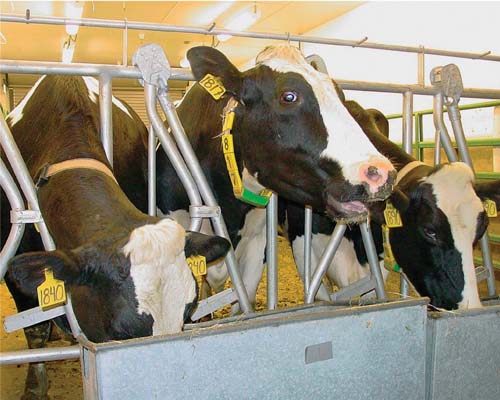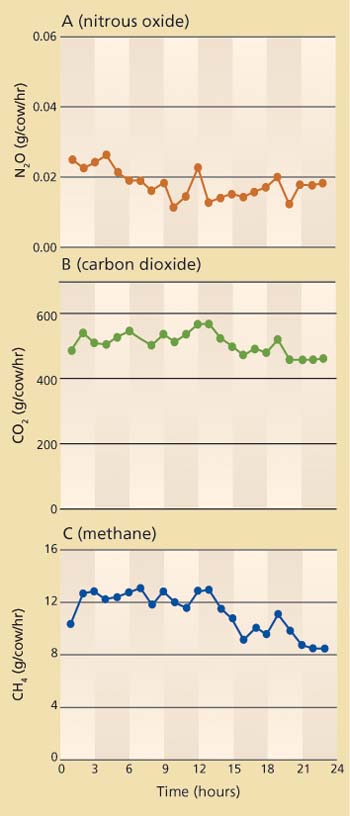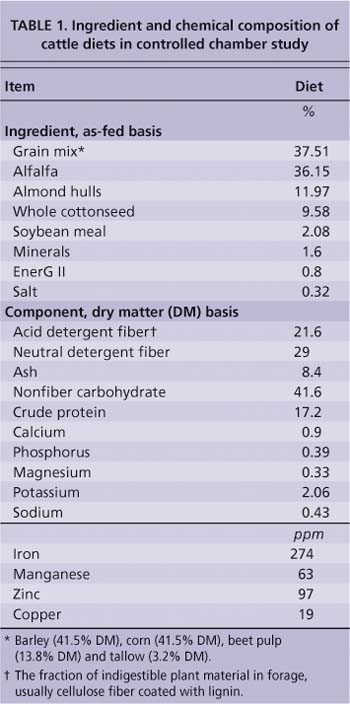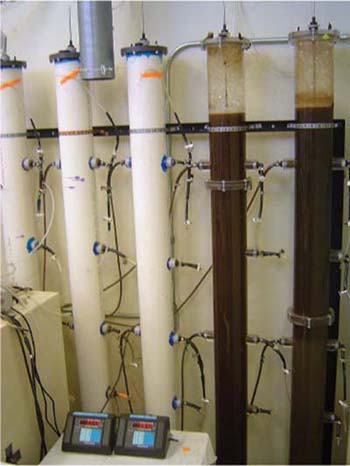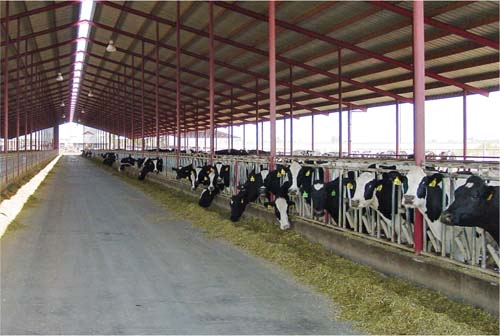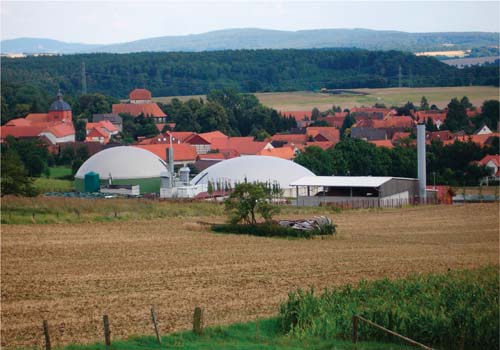All Issues
Direct measurements improve estimates of dairy greenhouse-gas emissions
Publication Information
California Agriculture 63(2):79-83. https://doi.org/10.3733/ca.v063n02p79
Published April 01, 2009
PDF | Citation | Permissions
Abstract
California is the leading dairy state in the United States, producing 21% of the nation's milk supply. The state's highest concentration of dairies is in the San Joaquin Valley, a region that violates federal limits for ozone and particulate matter in the air. Volatile organic compounds and greenhouse-gas emissions from dairies contribute to regional air-quality challenges and also play a role in climate change. We used an environmentally controlled chamber to monitor greenhouse-gas emissions from dairy cattle over a 24-hour period, and we measured the emissions from waste slurry using a simulated dairy waste lagoon. This research helps to quantify emissions from dairies in California and suggests possible approaches for their mitigation.
Full text
Warming of the climate system is unequivocal, according to the Intergovernmental Panel on Climate Change (IPCC 2007). Further, it is more than 95% likely that the observed increase in globally averaged temperatures since the mid-20th century is due to human activity, principally through the observed increases in concentrations of greenhouse gases. In other words, there is less than a 5% probability that this temperature increase is caused by natural climatic processes alone (IPCC 2007). Climate change will affect California in a number of ways, if it has not already.
The three major anthropogenic greenhouse gases are carbon dioxide, methane and nitrous oxide, and agriculture contributes significant amounts of each. The IPCC estimated that globally, agriculture contributed 10% to 12% of anthropogenic carbon dioxide (CO2, 40% of methane (CH4) and 60% of nitrous oxide (N2O) emissions in 2005. Agricultural processes and sources generating greenhouse gases include the burning of fossil fuels, deforestation, rice cultivation, biomass burning, enteric fermentation by ruminants (gas belched from the stomachs of cattle, goats and sheep), the fermentation of animal manure and the application of nitrogenous fertilizers. The livestock industry is estimated to contribute half of total U.S. agricultural greenhouse-gas emissions, with a quarter each coming from ruminant enteric fermentation and animal waste (USDA 2004).
Holstein dairy cows were housed in an environmental chamber for 24 hours to accurately measure all their emissions of greenhouse gases, including methane and nitrous oxide; the cows were fed a total mixed-ration diet.
Livestock emissions
Rurninants' enteric fermentation and manure produce both methane and nitrous oxide emissions (Kaspar and Tiedje 1981; IPCC 2007; Jarvis and Pain 1994; Jungbluth et al. 2001; Phetteplace et al. 2001). Considering the global warming potentials of these two greenhouse gases (see box, page 80), methane contributes an estimated three-quarters and nitrous oxide an estimated one-quarter of the total greenhouse-gas emissions in carbon dioxide equivalents from the U.S. livestock industry.
Methane.
Dairy cow methane emissions can be affected by factors such as animal feed intake, size and growth rate, milk production and particularly energy (carbohydrate and fat) consumption (Jungbluth et al. 2001). Most California dairies manage animal waste in corrals and flush liquid manure slurry with water into uncovered, anaerobic (oxygen depleted) storage lagoons. Each of these manure methods has different biochemical pathways that result in varied greenhouse-gas emissions rates. For example, corrals (or drylot systems) usually have relatively high nitrous oxide and low methane emissions, while anaerobic lagoons have low nitrous oxide and variable methane emissions (USDA 2004). Previous studies predicted methane emissions from dairy cows based on their physiology and the animal's feed energy consumption (Holter and Young 1992). Direct measurements of methane emissions from cows and dairy facilities have been made, but rarely under controlled conditions (Kinsman et al. 1995; Jungbluth et al. 2001; Sneath et al. 1997).
Nitrous oxide.
The manure of ruminant animals can be a considerable source of nitrous oxide. The production of this gas from dairy waste depends on the waste composition, bacteria involved and conditions following excretion. Mostly, nitrous oxide can be emitted as an intermediate product during nitrification (the aerobic process that forms nitrate from ammonium nitrogen) and denitrification (the anaerobic process that forms nitrogen gas from nitrate). These reactions generally occur in the soil when chemical fertilizers or animal manure nutrients are applied to crops (Groffman et al. 2000). Nitrate reduction (forming nitrogen gas) can occur in the rumen of the cow and then escape during eructation (belching of gas from the first stomach), resulting in the emission of methane and some other gases, including nitrous oxide. However, ruminant animals are considered a small source of nitrous oxide emissions (USDA 2004).
Compared to methane emissions, literature on nitrous oxide emissions from dairy cows is scarce (Jungbluth et al. 2001). Direct measurements of nitrous oxide emissions from dairy facilities range between 0.01 and 0.08 gram of nitrous oxide per livestock unit (1,102 pounds of animal) per hour (Amon et al. 2001; Jungbluth et al. 2001; Sneath et al. 1997).
Global warming potential of gases
Greenhouse gases absorb energy (heat) in specific wavelength bands in the infrared, also called thermal infrared or long-wave radiation. These gases include water vapor, ozone, carbon dioxide, methane (natural gas) and nitrous oxide. Water vapor is the most important because of its concentration in the atmosphere, but changes in water vapor concentrations are not responsible for observed climate warming (IPCC 2007). Other greenhouse gases also absorb outgoing long-wave radiation emitted by Earth's surface (blackbody radiation), and play important roles in absorption across certain atmospheric wavebands where water vapor is relatively transparent. Global warming potential (GWP) is an index for comparing the outgoing thermal infrared radiation trapped by a specific gas to that trapped by a reference gas, which is usually carbon dioxide. The atmospheric lifetime of both gases is also taken into account in the global warming potential calculation.
Both high thermal infrared absorbance and long atmospheric lifetime can elevate global warming potential. In greenhouse-gas inventories, the global warming potential of a gas or gas mixture is often expressed as carbon dioxide equivalents (CO2e). Methane and nitrous oxide have global warming potentials of 21 and 310 carbon dioxide equivalents, respectively, and are therefore important in discussions of climate change, even though their atmospheric concentrations are less than one-hundredth that of carbon dioxide.
Ozone in the lower atmosphere is also a greenhouse gas, although its effects on climate are complex and sensitive for its vertical distribution profile (Finlayson-Pitts and Pitts 2000). Ozone is the principal air pollutant in California air basins with regard to regional air quality. Ozone in the lower atmosphere is produced via reactions of volatile organic compounds and nitrogen oxides, in the presence of sunlight. Volatile organic compounds contain carbon and are found in the gas phase at typical ambient temperatures; they include compounds emitted from both anthropogenic sources (such as motor fuels) and biogenic sources (including green plants and animal agriculture). Nitrogen oxides are a byproduct of high-temperature combustion. Elevated levels of ozone are found where both volatile organic compounds and nitrogen oxide emissions are high, solar intensity is high, an air mass is trapped, and air temperature is high enough to allow rapid chemical reactions. Higher ambient temperatures during the summer, brought about by climate change, will tend to enhance ozone production in the lower atmosphere and provide positive reinforcement for additional temperature increases.
Fig. 1. Greenhouse-gas emissions from Holstein cows (three groups of three cows each; n = 3) housed in an environmental chamber, tested for (A) nitrous oxide (N2O), (B) carbon dioxide (CO2) and (C) methane (CH4) from cows and their fresh waste over 24 hours.
Volatile organic compounds.
Livestock also emit volatile organic compounds, such as alcohols, ketones, aldehydes and volatile fatty acids. Volatile organic compounds contribute to ozone formation, which acts as a greenhouse gas in the lower parts of the atmosphere (see box). However, there have been few reports on the emissions rates of volatile organic compounds from dairy cows and waste (Filipy et al. 2006; Rabaud et al. 2003). Miller and Varel (2001) measured alcohol concentrations in both fresh and aged cattle manure slurries under laboratory conditions. Martensson et al. (1999) monitored volatile fatty acids in dairy barns and detected acetic, butyric, lactie and formic acid in the air. With respect to ozone-forming volatile organic compounds, no comprehensive research had been conducted until a recent UC study (Shaw et al. 2007).
Dairy cow emissions
Controlled chamber.
In 2008, we used an environmentally controlled chamber at the UC Davis Department of Animal Science to measure greenhouse-gas emissions from lactating dairy cows and their fresh waste (fig. 1). The 185-cubic-yard chamber had one air inlet and one air outlet, and a continuous ventilation rate of 2,930 cubic yards per hour, or a 6-minute air turnover rate at 70°F and 1 atmosphere. We assembled three free-stall beds (rubber-floored individual resting places) so that the cows could rest, to simulate typical dairy free-stall housing conditions. Cows had free access to feed and water. Cow excreta (urine and feces) accumulated on the concrete floor until the chamber was cleaned. The Association for Assessment and Accreditation of Laboratory Animal Care International certified the environmental chamber facility, and the UC Davis Institutional Animal Care and Use Committee approved the project to certify the health and welfare of the animals.
Nine lactating Holstein dairy cows from the UC Davis dairy herd were used for the experiments, in groups of three. The average cow's weight in the study was 1,446 pounds, its dry matter feed intake was 25 pounds per cow per day, and its milk yield was 62 pounds per cow per day. Cows were fed a total mixed-ration diet (table 1).
Background air samples were collected in the empty chamber before the first hour of each 24-hour experimental period to assess baseline greenhouse-gas concentrations in the incoming and outgoing air. After 1 hour of empty chamber measurements, three cows were placed inside. The animals were kept in the chamber for 24 hours, and manure accumulated. The cows were milked with a mobile milking unit both before placement in the chamber and after 10 hours inside the chamber. After 24 hours, the cows were taken out of the chamber.
Emissions fluxes.
Nitrous oxide, carbon dioxide and methane emitted from the dairy cows and their fresh excreta were continuously measured using an INNOVA model 1412 Field Gas Monitor (INNOVA AirTech Instrument, Ballerup, Denmark). This gas analyzer can selectively measure up to five component gases and water vapor simultaneously through the use of optical filters. The detection limits of this analyzer were 210 micrograms per cubic meter (μg/m3) for methane and 39.9 μg/m3 for nitrous oxide. The greenhouse-gas emissions fluxes were calculated as the concentration difference between the chamber outlet and inlet air streams, multiplied by the constant air flow, as seen in the following equation: where E = gas emission rate from chamber (grams/hour); Cout = mass concentration in exhaust air (grams per cubic meter [grams/m3]); Cin = mass concentration in incoming air (grams/m3); Q = air flow at 68°F (20°C) and 1 atmosphere (m3/hr); n = total effective measurement numbers; and N = cow numbers.
Greenhouse gases measured
Methane.
When cows entered the chamber, methane fluxes immediately increased (fig. 1), indicating that enteric fermentation rather than fresh waste is the main process responsible for production of this gas from cows. After the cows were removed from the chamber, methane fluxes returned to background levels. The mean emissions rate of methane from lactating cows and manure was 11.36 grams per cow per hour. Fresh manure produces negligible methane fluxes, and under commercial conditions it is usually flushed out of the animal housing area into the waste lagoon three times per day on average. As a result, methane emissions from the animal housing components of a dairy can be estimated largely on the basis of animal (enteric) emissions. Several recent reports showed similar flux rates from lactating cow facilities (Kinsman et al. 1995; Sneath et al. 1997).
Nitrous oxide.
Kaspar and Tiedje (1981) reported that a small quantity of enteric nitrous oxide was emitted from cows. Similarly, we found nitrous oxide emissions of 0.02 gram per cow per hour (fig. 1).
Strategies to reduce methane emissions from dairies include modifying cattle diets to enhance digestibility and improving milk production so that fewer cows are needed.
Volatile organic compounds.
In a UC study, Shaw et al. (2007) showed that major volatile organic compounds from cows include methanol. This study also showed that of the volatile organic compounds from cows, the reactive (ozone forming) fraction was 6 to 10 times lower than the value for cows and fresh waste that California regulatory agencies have historically used to develop volatile organic compound inventories for ozone attainment in the San Joaquin Valley. Ozone contributes to global warming and thus all such ozone precursors should be considered in climate-change discussions.
Dairy waste lagoon emissions
To study greenhouse-gas emissions from liquid dairy waste storage, we simulated a column of dairy waste-water in a lagoon with laboratory-scale reactors — devices that support a biologically active environment. These reactors had a cylinder column made of polyvinyl chloride pipe that was 2.7 yards deep and 6 inches in diameter. The total liquid volume in each reactor was 1.3 cubic feet, and the total liquid depth was maintained at 2.33 yards. The reactors were initially seeded with liquid pumped from a commercial dairy wastewater lagoon. The liquid contained 0.41 pound per cubic foot (lb/ft3) total solids and 0.24 lb/ft3 volatile solids (organic compounds), and had a pH of 7.4. The reactors were operated according to the design guidelines of anaerobic lagoons for the San Joaquin Valley, with a loading rate of 0.32 pound volatile solids per cubic yard per day and a hydraulic retention time of 70 days.
A mixture of fresh dairy feces and urine was collected directly from lactating cows, and then diluted with fresh water and passed through a screen with 2-millimeter openings to make a manure liquid of 1.0 pound per cubic foot total solids and 0.75 pound per foot volatile solids. The reactors were fed with the manure liquid once a day. The average storage temperature of about 61.7°F (16.5°C) was close to the annual average temperature in the San Joaquin Valley. The headspaces of the reactors were provided with a fresh air-flow at a constant rate of 0.035 cubic foot per minute using compressed air, which was controlled with a mass-flow controller. Concentrations of greenhouse gases at the air inlets and outlets of the reactors were measured using the same INNOVA multigas photoacoustic monitor for 2 days every week. The entire experiment lasted 6 months.
The lagoon-water methane and nitrous oxide emissions were 0.46 ± 0.20 and 0.00095 ± 0.00015 gram per cubic meter per day, respectively. Assuming that a lactating cow produces 150 pounds of manure per day with 17.6 pounds of volatile solids, an average 65.4-cubic-yard lagoon volume is required for storage, based on standards from the American Society of Agricultural and Biological Engineers (ASABE 2005) and USDA (2004). In the present study, approximately 1.22 pounds of methane and 0.002 pound of nitrous oxide were produced from dairy-waste lagoon water per lactating cow per day.
Methane and nitrous oxide emissions from animal waste can also be calculated as described by USDA (2004). However, our study found a slightly lower methane and a higher nitrous oxide emissions rate than those predicted in the USDA study (2004). Their calculation showed that approximately 1.49 pounds of methane and 0.000926 pound of nitrous oxide per cow per day were emitted from the dairy wastewater lagoons, which are commonly used for manure storage at medium (200 to 700 head) and large (more than 700 head) operations in the United States, according to the EPA definition (US EPA 2007; USDA 2004).
Reducing livestock emissions
Enteric fermentation and waste-water lagoons are two distinct sources of greenhouse gases from livestock, especially methane emissions from dairies.
There are a number of potential strategies to effectively control methane emissions from enteric fermentation (Mosier et al. 1998; USDA 2004). USDA (2004) suggested that these strategies may include: (1) increasing the digestibility of forages and feeds by making feed digestion more efficient; (2) using feed additives to tie up hydrogen in the rumen, because hydrogen is an important intermediate product to produce methane; (3) inhibiting rumen bacteria (methanogens) that produce methane; (4) enhancing rumen microbes to produce usable product rather than methane; and (5) improving milk production efficiency to reduce animal numbers.
Likewise, multiple options are available for reducing greenhouse-gas emissions from dairy waste. In general, oxygen inhibits the methanogens in cow waste, which then produce less methane. Our recent study showed that the partial deep aeration of lagoon water can reduce methane emissions significantly (data not shown). However, these systems produce higher nitrous oxide emissions, which could offset the methane reduction likely due to increased nitrification rates (USDA 2004).
Anaerobic digestion systems (covered lagoons or methane digesters) are another option for reducing greenhouse-gas emissions from dairy waste. Unlike conventional uncovered lagoons, digestion technologies provide actual treatment through increased microbial processes. From a waste treatment standpoint, anaerobic digestion systems could be one of the best available technologies to reduce greenhouse gases from dairies (USDA 2004).
However, future research is needed to address the mitigation of methane and nitrous oxide from cow enteric fermentation, which we have shown to be the chief of all dairy contributors to climate change.
Covered lagoons and methane digesters are an option for reducing greenhouse-gas emissions from dairy waste. In Germany, the village of Juehnde built a digester for livestock waste and other biomass. The methane is combusted to produce electric power and heat for homes in the village, which is the first in the world to go “off the grid” through the use of its own waste.



